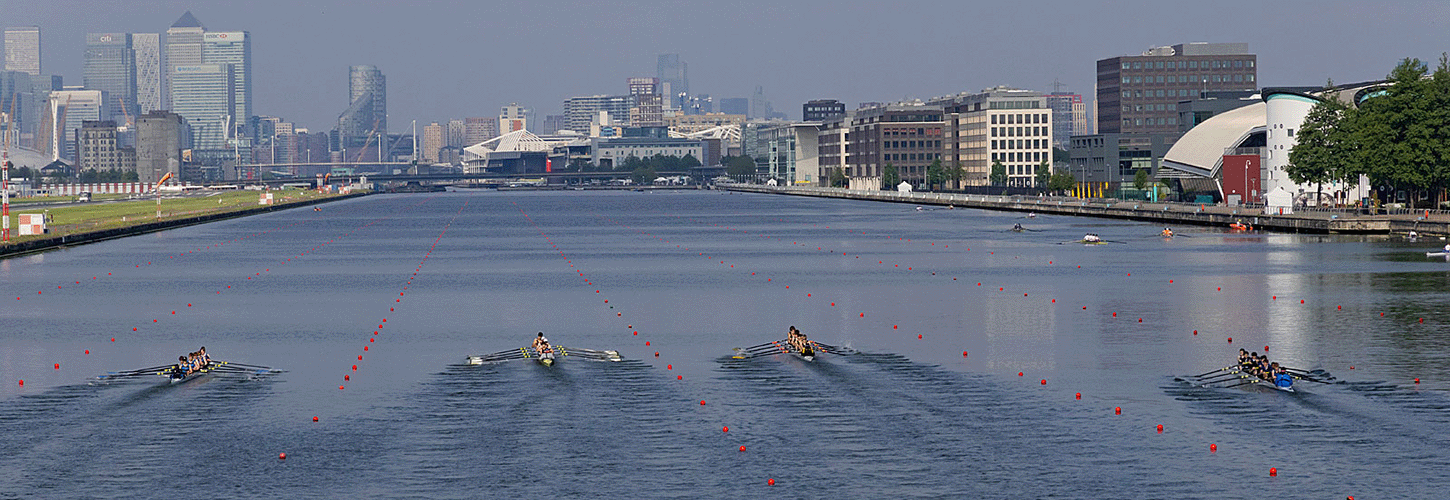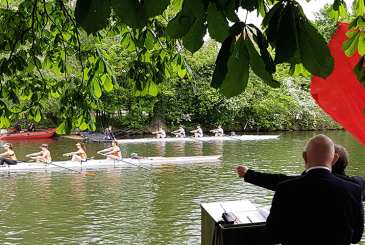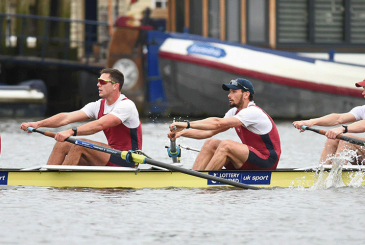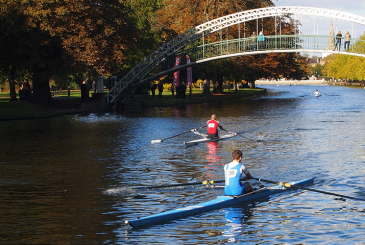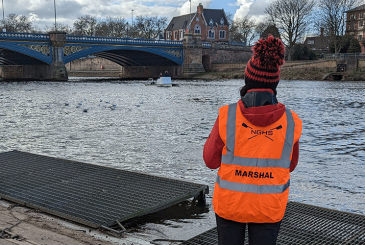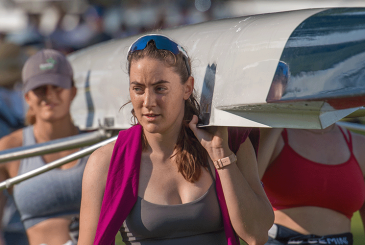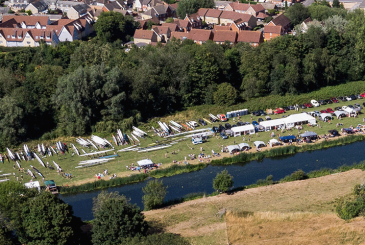Regattas held on the multi-lane courses like Nottingham, Dorney and London Docklands are key competitions in the early part of the summer season for many crews. For a cox or steers, competing six abreast can look daunting but keeping your approach simple is likely to be the best way to get a good outcome.
Cox Cameron Moffat was at the helm of an Oxford Brookes men’s eight that recorded an outstanding time of five minutes 38 seconds on the multi-lane course at Ghent in Belgium in 2022. Eloise Etherington sat at bow, made calls and steered the GB quad to medals at each of the last two World Rowing U19 Championships. They share their advice on making sure you finish out front in a six-crew field.
Prepare before you race
There is only so much that a cox or steers can say during the race, so the information you gather and conversations you have beforehand play a large part.
Make sure you know whether the start will be given by the umpire using a flag or a traffic light system. In a heat or semi-final, know what the progression system is for qualification to the next round.
Many competitions use a time trial to seed side-by-side racing. Study the results carefully to get an idea about who is likely to be close to you in speed and which crews – if any – will probably be out the front.
Cameron adds, “You may have a Club category and an Academic category within the same race so you might [be able to] think, ‘Which crew do I actually need to worry about if we want to win?’”

It is also worth talking about what you will do if something goes wrong, as it did for Eloise off the start at Metropolitan Regatta last summer.
She recalls: “It was a massive cross wind, there was a gap between ‘attention’ and ‘go’, the boat swung and we went straight into the buoys in the first three strokes. But then that’s what you plan for.
“We talk about it beforehand: If something happens, what do you do? You just carry on and get back into the rhythm and we managed to do that.”
In control before the start
A crew that is calm before the start is likely to be better focused once the race begins so practising how to back onto a stake boat and align properly is important.
For Cameron, getting onto the stake boat is a final pre-race opportunity to bring the crew together. He tends to hand over responsibility to stern pair to back down – especially in a bow-loading four – and to bow for tapping around.
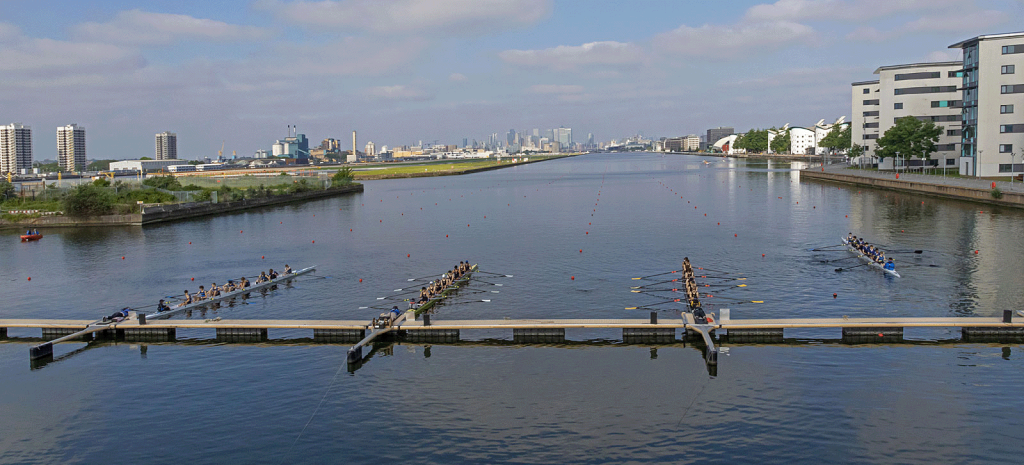
“Everyone wants to get onto the stake boat promptly because there’s nothing more stressful for a crew than when they’re late to the start or they can’t back on,” he says.
Dorney Lake in particular tends to suffer from crosswinds, making it key to angle the bow into the wind.
Eloise explains: “I don’t want to be taking taps between ‘attention’ and ‘go’. If I know the crosswind is going to blow us in one direction, I’ll angle the boat a bit into it. Then you know by the time they say ‘go’, you’re straight. But it’s hard to judge.”
Off the start
There’s a lot going on at the start in multi-lane racing and it is important to stay focused on your race plan.
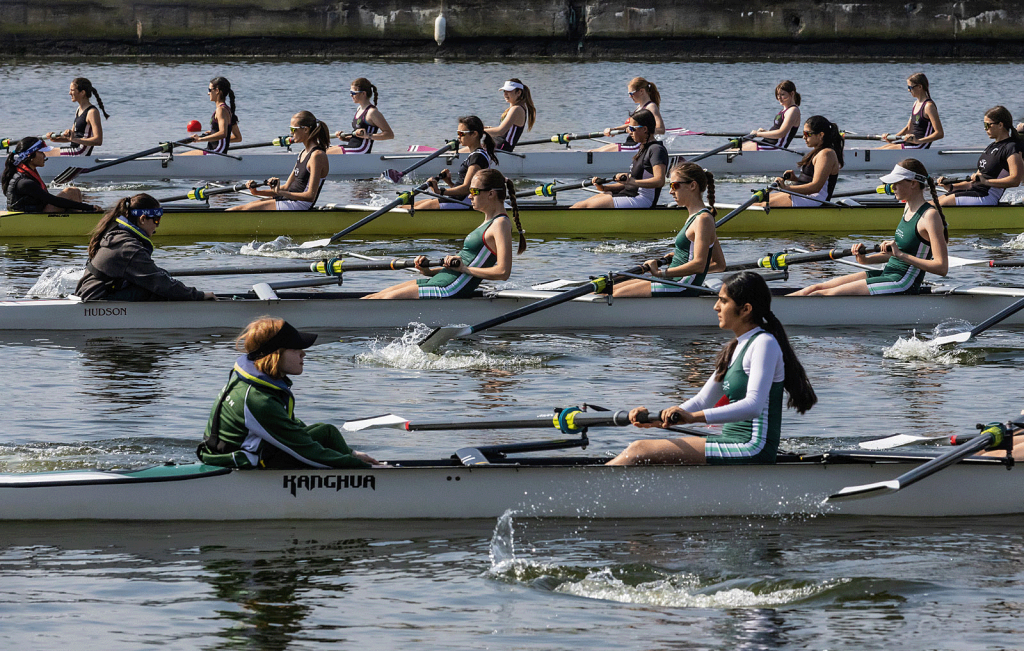
Cameron says: “The noise off the start in a multi-lane, especially in the eights, there’s nothing else like it!
“If you spend the whole race looking left and right, you’re not going to do very well at what you need to do. The crew will feed off your signals as well. You set the mood of the crew. You’ll only get so much out of your athletes if you go into panic mode.”
Eloise adds: “We were always very internal for the first minute. You want to get your start sequence done. Especially while you’re at higher rates, looking around I find can disrupt it a bit more. So I wait until we’ve settled on to the race rhythm.”
Assessing distance and positioning
Distance markers are a feature of lakes that you are unlikely to see in river racing but be careful not to allow them to over-complicate the race. If you do use them, make sure you know whether the marker tells you how far you have gone or how much distance is left.
“I would recommend somebody use the data that’s in front of you because that’s easier to gauge. Most stroke coaches will have GPS,” says Cameron.
Your crew will want to know where they are in the race but looking too much may slow you down, especially as a bow steers.
“I would say it’s worth taking a proper look, but do it once. Take a proper look and then trust that you’re going to make your move,” says Eloise, recalling the semi-final at U19 Worlds in 2023.
“It was neck-and-neck and I kept looking over. That just doesn’t help when you’re trying to sprint. You have to look, know where you are, commit to the move as a crew. And you know, if it works, it works.”
It worked. GB won their semi-final with the top four boats within two seconds of each other and only three qualifying for the final.
Steer off the buoy line
From the bow seat of a quad, it may be difficult to see the ‘vanishing point’ of two sets of buoys in the distance but it important to steer to the buoy line rather than other crews.
Remembering her early steering experiences, Eloise admits: “When I got close to a buoy line I used to kind of panic and just jam the foot the other way. So then, by the time you’re clear you’re actually 30 degrees off the other way. And so you keep zigzagging.
“It took me a long time to learn. And I had to practise it, steering next to a wall or something wherever possible. If you’re parallel to something and just too close to it, that’s better than going too far the other way.”
Careful when you call
Cameron and Eloise both say they can hear opponents making calls mid-race and will react to them.
“You’re loud enough at bow that people in the lane next you can hear. So if you hear another crew going from push, then obviously I’m going to respond to that with something,” Eloise explains.
“So we tried to use different words that only we knew. ‘Stamp’ was one big one. The key is not to shout it aggressively like you would for push. You call it more as a technical call, loud enough and clear enough that everyone’s heard, but in a calm way.
“You make that call, everyone commits fully and it takes the other boat that much more time because they don’t really realise what you’re doing until you’re gone.”
Stick to the plan
Even if your crew isn’t out front, it is important for a cox or steers to stick to the plan in multi-lane racing. Knowledge of the strengths of the crew and conversations before racing all play a part here.
Cameron’s kept his crew patient in the final of Men’s Championships Coxed Fours at Marlow Regatta in 2022.
“We won the time trial but there were only a few seconds separating the top six boats so we knew we were in in for a gut-buster,” he remembers.
“Our coach told us: ‘Your [physical] strength is your strength. If you utilise that in the middle of the race and you’re working when everyone else has absolutely nothing in the tank you will be amazed how quickly the tide can turn.’
“We were the last boat to 750m but because the coxed four is such a slow, heavy boat to move, we just had so much horsepower we went from last to first in about 500m and then came away with the win by about two lengths.”
Learn more about racing
- How to warm up for rowing >>
- How to do racing starts >>
- Race tactics: A physiological perspective on 2k racing >>
- Race tactics: A physiological perspective on 1k racing >>
- “Recovery begins the second you finish your final stroke” >>
Photos: Carole Milligan/Poplar Regatta 2024.


